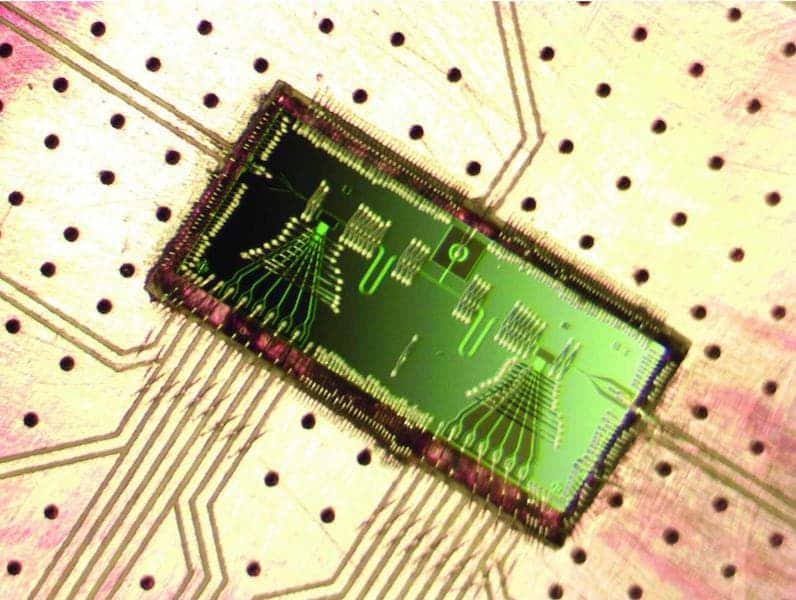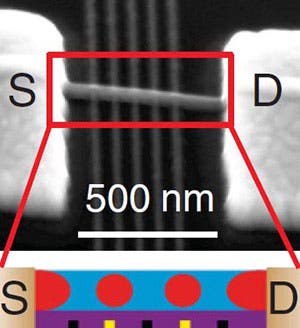Princeton researchers demonstrated a novel type of microwave laser – called a maser – so small that’s the size of a grain of rice. The laser is powered by individual electrons that tunnel through artificial atoms known as quantum dots.
A tiny microwave laser
Quantum dots, among other things, have the potential to revitalize the LCD screens in our phones, tablets, TVs and laptops. For instance, it’s widely rumored that Apple’s new iPhone 6 will exploit these, but what are quantum dots? Quantum dots are incredibly small particles that range between 2 to 10 nanometers in diameter or the equivalent of 50 atoms. Simplifying things further, quantum dots are semiconductor nanocrystals with unique properties, including the ability to emit light at very specific wavelengths. Sort of like microscopic pieces of glitter that glow green, red, or blue depending on their size.

This rice grain-sized laser powers quantum dots one electron at a time. Credit: Jason Petta, Princeton University
Princeton physics associate professor and lead researcher for the study Jason Petta says that the new microwave laser – or maser – is about as small as one can possibly go with a single-electron device. The laser only uses a billionth of the electrical power used by a hair drier and was made to explore the possibility of using quantum dots as potential viable components for next generation quantum devices. Ultimately, the Princeton researchers aim to merge doubled quantum dots to make quantum bits or qubits – the fundamental unit of information of quantum computers or the equivalent of bits for classical computers.
Where traditional computers perform their calculations in binary – using 1s and 0s – quantum computers exploit the odd characteristics of the quantum state of particles at the atomic scale. Like Schrödinger’s cat, the value of a qubit isn’t definitely 1 nor 0, but both at the same time. To “solve” a calculation, the quantum state is ended, so that the qubits take a classic 1 or 0 value. Setting the quantum states and superposition up correctly should mean a quantum computer will reach the same answer as a normal one. Unlike a conventional computer that needs to reach an answer sequentially, a qubit will instantly collapse to find the answer. This means that brute force operations that can take months for even today’s fastest supercomputers could be quickly and effortlessly solved by a quantum computer, or so the theory goes.
“These double quantum dots are zero-dimensional as far as the electrons are concerned — they are trapped in all three spatial dimensions,” Petta explains.
This sort of communication, vital for quantum computers, is envisioned to work by entangling light photons, so the Princeton team built quantum dots that emit a photon when a single electron drops from higher energy state to a lower one, thus migrating across the dot. This is why they build their maser, which directs electrons one at a time through each double quantum dot. The laser itself emits energy in the microwave range, and researchers say it’s an excellent way to demonstrate how light and moving electrons interact.

A double quantum dot as imaged by a scanning electron microscope. Current flows one electron at a time through two quantum dots (red circles) that are formed in an indium arsenide nanowire. (Photo courtesy of Science/AAAS)
Read more: Rice-sized laser, powered one electron at a time, bodes well for quantum computing
This maser and quantum dot system is yet another step in the long stride towards building the first truly functional quantum computer – the kind that is set to revolutionize the way computing as we know it being made.
“I consider this to be a really important result for our long-term goal, which is entanglement between quantum bits in semiconductor-based devices,” study co-author and research collaborator Jacob Taylor of the University of Maryland says.
“This is the first time that the team at Princeton has demonstrated that there is a connection between two double quantum dots separated by nearly a centimeter, a substantial distance,” he says of the latest work.
Findings appeared in the journal Science.









